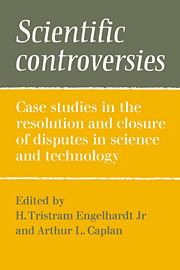 Scientific Controversies
Scientific Controversies Book contents
- Frontmatter
- Contents
- Preface
- List of contributors
- Introduction: Patterns of controversy and closure: the interplay of knowledge, values, and political forces
- PART I THEORETICAL PERSPECTIVES
- PART II CONTEMPORARY CASE STUDIES
- 12 Resolution of the Laetrile controversy: past attempts and future prospects
- 13 Federal regulation of Laetrile
- 14 Quasi libertarianism and the Laetrile controversy
- 15 Judicial deflection of scientific questions: pushing the Laetrile controversy toward medical closure
- 16 Politics, science, and the problem of psychiatric nomenclature: a case study of the American Psychiatric Association referendum on homosexuality
- 17 The diagnostic status of homosexuality in DSM-III: a reformulation of the issues
- 18 On arriving at the American Psychiatric Association decision on homosexuality
- 19 Values in the debate over workplace safety and health: the rancorous rhetoric about regulation
- 20 The successful experiment that failed
- 21 The power of efficiency: balancing benefits and costs in regulating occupational exposure to toxic substances
- 22 Closure in occupational safety and health: the benzene and cotton dust decisions
- 23 Nuclear fear: a history and an experiment
- 24 Closure and controversy: Three Mile Island
- 25 Understanding the nuclear power controversy
- PART III CONTROVERSY, CLOSURE, AND THE PUBLIC
- Author index
- Subject index
17 - The diagnostic status of homosexuality in DSM-III: a reformulation of the issues
Published online by Cambridge University Press: 03 February 2010
- Frontmatter
- Contents
- Preface
- List of contributors
- Introduction: Patterns of controversy and closure: the interplay of knowledge, values, and political forces
- PART I THEORETICAL PERSPECTIVES
- PART II CONTEMPORARY CASE STUDIES
- 12 Resolution of the Laetrile controversy: past attempts and future prospects
- 13 Federal regulation of Laetrile
- 14 Quasi libertarianism and the Laetrile controversy
- 15 Judicial deflection of scientific questions: pushing the Laetrile controversy toward medical closure
- 16 Politics, science, and the problem of psychiatric nomenclature: a case study of the American Psychiatric Association referendum on homosexuality
- 17 The diagnostic status of homosexuality in DSM-III: a reformulation of the issues
- 18 On arriving at the American Psychiatric Association decision on homosexuality
- 19 Values in the debate over workplace safety and health: the rancorous rhetoric about regulation
- 20 The successful experiment that failed
- 21 The power of efficiency: balancing benefits and costs in regulating occupational exposure to toxic substances
- 22 Closure in occupational safety and health: the benzene and cotton dust decisions
- 23 Nuclear fear: a history and an experiment
- 24 Closure and controversy: Three Mile Island
- 25 Understanding the nuclear power controversy
- PART III CONTROVERSY, CLOSURE, AND THE PUBLIC
- Author index
- Subject index
Summary
In 1973 the American Psychiatric Association Board of Trustees passed a resolution that removed homosexuality per se from the list of mental disorders in the second edition of the association's Diagnostic Manual of Mental Disorders (DSM-II). This decision was made after an acrimonious debate within the association initiated by lobbying efforts by gay activists. In the place of the category of homosexuality was substituted a category called “sexual orientation disturbance” that was for “individuals whose sexual interests are directed primarily toward people of the same sex and who are either disturbed by, in conflict with, or wish to change their sexual orientation.” In a statement supporting the board of trustees' action, I maintained that the revision was “scientifically sound and a reasonable compromise between two extreme viewpoints about homosexuality held by many members of our profession. It avoids commitment to either the notion that homosexuality is invariably a mental disorder or that it is merely a normal variant of heterosexuality.” However, those who opposed the resolution and argued that homosexuality always represents psychopathology regarded the decision as a triumph of politics over science.
It is not surprising that those who had opposed the 1973 decision made no attempt to reopen the question of the classification of homosexuality as a mental disorder when, in 1974, work began on the third edition of the manual (DSM-III) under my leadership as newly appointed chairperson of the APA Task Force on Nomenclature and Statistics. First, these individuals may have assumed that in view of the central role that I played in the 1973 decision, their views would hardly be given a favorable hearing.
- Type
- Chapter
- Information
- Scientific ControversiesCase Studies in the Resolution and Closure of Disputes in Science and Technology, pp. 401 - 416Publisher: Cambridge University PressPrint publication year: 1987
- 1
- Cited by
